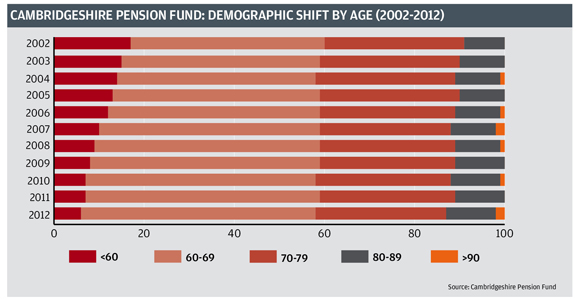Cambridgeshire Pension Fund outperformed in 2012/2013 after a restructure of its fixed income investments saw it buy European loans to increase yield and protect itself against rising interest rates.
Historically low gilt yields have caused many schemes to decrease their reliance on government debt and prompted schemes to increase investments in riskier, yet higher-yielding fixed income.
Cambridgeshire's asset allocation
Equities: 68.6%
Bonds: 14.8%
Cash: 2.8%
Alternatives: 6.7%
Property: 7.1%
Source: 2012/2013 annual report
Following a review of its bond portfolio in 2011, Cambridgeshire began to sell its gilt holdings to fund the loans as well as an absolute return bond strategy.
“[The bond restructure was] designed to increase the overall level of yield and provide some protection against a scenario of rising interest rates and falling bond prices,” the fund’s draft 2013 annual report stated.
This strategy shift helped deliver a return of 15.5 per cent for the year, outperforming its benchmark return of 13.6 per cent. The outperformance was attributed to fund's global equity and bond managers who "achieved returns well ahead of their respective benchmarks".
It also reviewed its use of active and passive management, comparing performance and fees. The scheme has decided to focus active management on areas where managers are more likely to outperform.

Mark Nicoll, partner at consultancy LCP, said the use of active fixed income management is expected to continue. "[Schemes] are very unsure about economic data coming out. In that sort of environment it is a good idea to diversify and give managers the ability to switch between assets," he added.
The scheme made the fixed income changes because it felt a passive approach could not offer the ability to access different asset types such as government, corporate, and high-yield bonds, and loans. It will review this approach in September.
Fixed income portfolios go global
Consultants have reported a greater tendency on the part of pension schemes to explore and take on the risk of different parts of the fixed income markets.
"It is interesting to see how [UK schemes'] bond portfolios are internationalising... there is a willingness to go further afield," said Tapan Datta, partner at Aon Hewitt.
The consultancy has seen increased interest from schemes in US high yield bonds, European high yield bonds, senior secure loans and emerging market debt.
But Datta warned investing in these assets brings other currency and emerging market risks to portfolios, and the trend towards diversifying fixed income portfolios may slow.
"There are two competing factors – strategically there is a greater sense of willingness to tolerate risks in the search for yield. But on the other side of the coin, with gilt yields rising, the incentives to do so will reduce," he added.
Cambridgeshire and Northamptonshire county councils implemented a shared service model in 2011 to save costs.
The collaboration known as Local Government Shared Services saw a cut in the number of jobs and a focus on directly investing in assets.






















